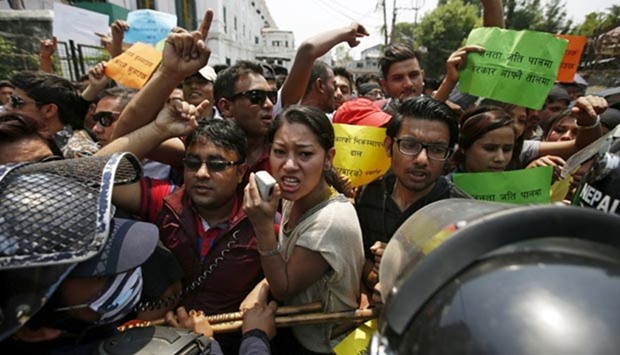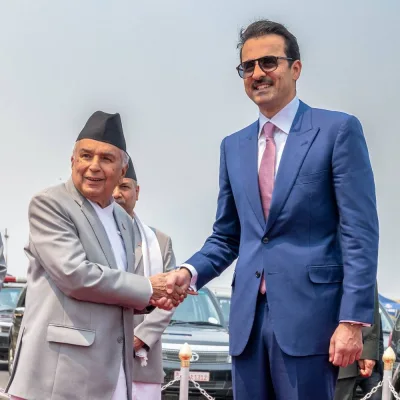Mourners carrying candles and Nepali flags packed into Kathmandu's badly damaged historic square to pray and to mark the anniversary of the quake that ripped through the impoverished country, killing almost 9,000 people.
Thousands more were left injured in the 7.8-magnitude quake that triggered avalanches and landslides across the Himalayan nation and flattened whole villages.
"It is emotional to be here... it feels good to come together like this," said Ajay Adhikari, a 26-year-old artist who lost his grandfather in the disaster.
"Tonight is a chance to pay tribute to him," Adhikari told AFP as he joined the crowds for a candle-light vigil in Kathmandu Durbar Square, which was lit up with traditional butter lamps.
Prime Minister K.P. Sharma Oli earlier laid flowers at a destroyed 19th-century tower in Kathmandu, while Buddhist monks in maroon robes held prayers at the site of another popular, now-destroyed temple.
Despite the solemn occasion, frustration against authorities flared on Sunday, with around 100 protesters marching towards government offices in the capital to demand faster reconstruction efforts.
Temporary shelters
About 4mn survivors still live in temporary shelters across the country one year on from the quake, according to the Red Cross.
Chhuldim Samden, a 21-year-old student, said she was fed up of waiting for help as she and her family struggle to survive in a shack.
"Even after one year, so many people are staying in tents, we are still living in a shack," Samden told AFP as she took part in the protest. "Where did all the donations go?"
Although international donors pledged $4.1bn to aid Nepal's recovery, political wrangling over control of the funds and delays in setting up the National Reconstruction Authority mean most victims have received nothing beyond an initial small payout.
Following a storm of criticism, the government has vowed to kickstart the reconstruction of schools and hospitals and speed up the distribution of the first $500 instalment of a $2,000 payout promised to homeless survivors.
Trekking guide Govinda Timilsina told AFP his life has been on hold since losing his house. He has been unable to rebuild his home himself because of the government's complex rules over qualifying for quake aid.
"The government rules were so confusing, we were scared we would not get compensation if we started work on our own," said Timilsina.
'Remember us survivors'
Apart from the damage to hundreds of thousands of homes nationwide, the disaster reduced more than a hundred monuments to rubble and damaged another 560 structures, including centuries-old temples and royal palaces in the Kathmandu valley that attracted visitors from around the world.
In the historic town of Bhaktapur, many of the traditional brick houses that made it famous have been replaced by grey tents and rusty tin shacks where women like Laxmi Nyapit are now forced to raise their children.
"Unless we get help, I don't know how we will ever live in a house again," the mother-of-three told AFP while sitting in her tent, which houses a bed and a stove.
Nyapit, who has received just $150 from the government, said memorial ceremonies meant little.
"They have to remember those who died, but first they have to remember us survivors and come here to help us," said the 40-year-old, who earns 35 rupees (32 US cents) a day from knitting gloves.
"If our government cared, we would not be living like this after a year."
The disaster struck on April 25 but commemorations were being held on Sunday - the quake anniversary according to the Nepali calendar.
More than 1,200 health centres were also damaged and nearly 8,000 schools were destroyed or left unsafe, leaving almost 1mn children without classrooms.
Tired of waiting, about 110,000 families have moved back into homes that are still at risk of collapse. More than 31,000 victims have also rebuilt their own houses, taking out loans or turning to charities for help.
On top of the financial losses, pegged at $7bn, the disaster also delivered a severe blow to Nepal's already weak economy.



